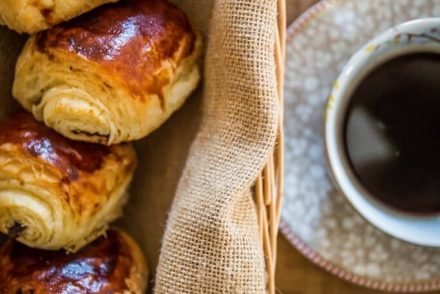There are only a handful of days left before 2017 and this post has been on the launch pad for about 4 weeks now.
I was lingering due to lack of contents, or at least I convinced myself of this. When I was reading again the method, the recipe seemed “so much” to me, that any introduction appeared inadequate and simplistic in comparison. Therefore, in the past month I turned on the pc at least every 2 days, looking at the pictures only to turn it off again without concluding anything.
Then this morning, while I was starting off the day, full of good intentions, with a cup full of Greek yogurt (I am always very health-conscious at 9am, it’s the remaining 14 hours that mess up all plans), I had a simple thought: what more do I need to add to a dessert that carries the name Opéra? What can possibly be missing from a gâteau made of biscuit Joconde moisten with coffee syrup, of ganache, of coffee buttercream and cacao glaze? Maybe only a few guests, and a special occasion. New Year ’s Eve is perfect, even though I would recommend to serve it before the lentils.
And on the morning of January 1st, while you’re dragging yourself around the house in your slippers and dressing gown, with a mid-height gaze and the Radetzky March in your ears, you will dream to find one last piece on the table, between the trays of cotechino sausage and the panettone’s glace fruits.

Opéra
TIPS
Ensure you get the roll measures right while you’re making it because it will need to fit in the fridge to set. In case, you can cut the almond sponge in half crosswise and make two rolls (like I did), so that it’s easier to fit both halves in the fridge.
EQUIPMENT
Food machine with wire whisk
Electric hand whisk
Sieve
Spatula
Baking tray
Baking paper
Thermometer
Balloon whisk
Sharp knife

Opéra
INGREDIENTS & METHOD
For the almond sponge
175 g eggs (approx. 3) at room temperature
70 g egg yolks (approx. 4) at room temperature
245 g almond paste at 70%
115 g egg whites (approx. 3) at room temperature
80 g caster (superfine) sugar
115 g all purpose flour (W160/180)
Cover a rectangular cake pan with parchment paper, making it stick by brushing a bit of butter. The baking tray of your oven will do.
Pre-heat the oven to 180° C.
Mix eggs and egg yolks in a bowl. Warm them up in a bain marie or in the microwave (heat them at full power for 5 seconds, then turn off, then on again for another 5 seconds etc.) until they reach a temperature of 28/30°.
Pour the almond paste in the food machine bowl, mix it a bit to make it easier to handle and then add the eggs. Attach the whisks and beat the mixture until it doubles in volume.
In a clean bowl beat the egg whites using an electric hand whisk: when they begin to foam, gradually add the sugar. Continue to beat until the mixture is glossy and stiff enough, but not too much, otherwise it will be difficult to incorporate it to the egg mixture.
Add the egg whites, a bit at a time, to the egg mixture and incorporate well, working with a spatula from the bottom of the mixture towards the top. During this step rotate often the bowl so that you catch all the mixture. Ensure there are no egg whites residues.
Gradually sift the flour onto the mixture while continuing to fold with the spatula as described above.
Pour onto the baking tray, distribute the mixture with the spatula without pressing it too much and create an even layer. Bake for 15 minutes. If you notice bubbles forming while in the oven don’t worry, maybe the flour was added too quickly. Once out of the oven they will disappear.
Remove from the oven and leave to cool down. Cover with a tea towel or cling film to prevent it from getting dry.
For the coffee syrup
4 g gelatine
175 g water (+ some for the gelatine)
40 g sugar
55 g coffee paste or 100 g liquid coffee
Soften the gelatine in cold water for 20 minutes.
In a pan, heat up the 175 g water and the sugar until it’s melted, then add the coffee (or coffee paste). Add the gelatine and leave it to cool.

Opéra
For the Chocolate Ganache
310 g of Caraïbe Valrhona baking bar (or good quality dark chocolate over 60%)
450 g crème fraîche
Break the chocolate into small pieces and add them to a container. Boil the crème fraîche and pour it, a bit at a time, on top of the chocolate. Mix well and then blitz it with a hand blender until perfectly combined. Set aside, keeping it at room temperature.
For the coffee buttercream
150 g egg whites
200 g sugar
50 g water
350 g butter at room temperature
120 g coffee paste
(—>To make it: 100 g instant coffee in 80 g boiling water, then add 20 g dextrose mixing until fully dissolved. Leave it to cool and keep it in the fridge in an airtight container. The dextrose will help to preserve the paste, preventing crystals from forming).
To prepare the coffee buttercream, start by making the Italian meringue.
Add the egg whites to the food machine bowl, fitted with a wire whisk attachment.
In a saucepan with pour spout, add the water and then the sugar. Leave on high heat without mixing. Once the syrup reaches 121°, remove from the heat. When the syrup is at 110°C, start beating the egg whites on medium speed. Do not beat until you get stiff peaks: the egg whites must be foamy and still quite soft when you pour the syrup. When the syrup reaches 121° remove it from the heat, stop the food machine, then add the syrup in the middle of the egg whites. Start again the food machine and bring it to high speed: continue to beat until the Italian meringue reaches 45 / 50 degrees (check the temperature with the thermometer). Finally, add the coffee paste, continuing to whisk until fully combined.
Pour the mixture into a container. Wash the food machine bowl then insert the creaming beater attachment. Beat the softened butter until it is fluffy and of a consistency similar to the Italian meringue. When it’s nicely fluffy and soft, gently fold the Italian meringue into it using a spatula.
For the chocolate glaze
110 g water (+ some for the gelatine)
300 g caster (superfine) sugar
100 g cacao powder, sifted
210 g fresh cream 35% fat
10 g gelatine sheets
Soften the gelatine in cold water.
In a saucepan, pour the water and the sugar, mix and bring to the boil. Keep mixing every now and then to dissolve the sugar more quickly. Once boiling, reduce the heat and let it simmer until the sugar is fully dissolved and transparent (it should take a few minutes). Remove from the heat and gradually pour the sifted cacao powder while continuing to mix with a small balloon whisk to avoid lumps. Bring the fresh cream to the boil then add it to the cacao and syrup mixture and stir.
Once the mixture reaches 70° C add the softened gelatine. Mix well and leave it to cool for 12 hours in an airtight container.

Cake Opera
To assemble the cake:
Place the almond sponge on a worktop, over a baking sheet.
With a sharp knife, gently scratch the surface of the sponge to remove the first, darker layer, in order to obtain a more porous surface. If you can’t quite complete this step to perfection, don’t despair: you can skip this part, it just will be a bit harder to spread the chocolate ganache.
Using a brush, moisten well both sides of the almond sponge with the coffee syrup.
Pour the chocolate ganache and spread it with a spatula over the entire surface.
Leave to set for 20 minutes in the refrigerator. Remove and pour a layer of coffee butter cream over the chocolate ganache, levelling it with the help of a spatula.
Roll up the biscuit, closing it well, with the help of the baking sheet underneath the base. Try to avoid empty spaces when you’re rolling it up and give it a nice cylindrical shape. Compact it with your hands, wrap it in baking paper and leave it to set in the fridge for about 4 hours.
Once cooled, place it on a rack over a baking tray. To make it easier to move the Opéra once completed, place two small serving spatulas or two wide blade knives between the rack and the roll, at two points equidistant from the ends. They’ll be handy to lift the roll and move it to the serving dish once the glazing is done.
Mix the chocolate glaze. It should be fluid but not too liquid, like extra-thick Italian hot chocolate. Warm it up in the microwave until it reaches approximately 35° C. Generously pour the glaze over the roll, ensuring it’s well covered everywhere. The excess glaze in the tray can be saved for other recipes (it’s perfect for glazing cream puffs, or eclairs, or a chocolate cake and it keeps in the fridge up to a few weeks).
Let the glaze set, then cut both sides of the roll so that all layers are visible and place on a serving plate. Decorate with a gold leaf.







4 Comments
how long in advance would you make this? I would like to make this for my mom’s birthday which is mid-week and wondering if it would be acceptable to make over the weekend. Are there individual portions you would make in advance? thanks!
Sabina
Hi my dear Sabina and sorry for my late reply but I didn’t get your message on my mailbox.
Your mum’s birthday is passed by and I’m very sorry for that! For the future… yes, you can make the roll some days in advance and, yes, you can cut it in individual portions. The cake is very rich, so you can realize many slices! With my roll I made about 12 slices.
Hi,
Sorry for such a question, but is it anyway I can make the syrup and the glaze with something other then gelatine? And the cake looks amazing!
Karine
Hello and sorry for my late answer. I’ve never tried other glaze so I can’t help you. So sorry!